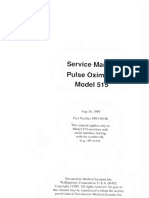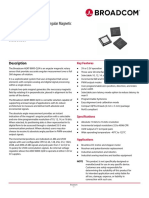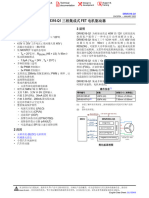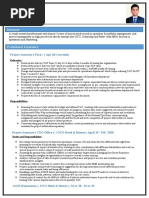Swra 471
Swra 471
Uploaded by
Nguyễn CườngCopyright:
Available Formats
Swra 471
Swra 471
Uploaded by
Nguyễn CườngOriginal Title
Copyright
Available Formats
Share this document
Did you find this document useful?
Is this content inappropriate?
Copyright:
Available Formats
Swra 471
Swra 471
Uploaded by
Nguyễn CườngCopyright:
Available Formats
Application Report
SWRA471 – December 2014
CC112X/CC120X On-Chip Battery Monitor
Fredrik Eriksen
ABSTRACT
This application report provides the necessary information in order to use the voltage sensor of the
CC112x and CC120x family. The voltage sensor can be used to monitor the supply and battery voltage
(VDD).
Contents
1 Acronyms Used in This Document ........................................................................................ 2
2 Digital Readout of Supply Voltage (VDD) .................................................................................. 2
3 Calibration Example ......................................................................................................... 3
4 References ................................................................................................................... 4
Appendix A CC120X Code for Digital Readout................................................................................ 5
List of Tables
1 Register Settings for Digital Readout Using CC112X ................................................................... 2
2 Register Settings for Digital Readout Using CC120X ................................................................... 3
3 ADC Value vs Supply Voltage ............................................................................................. 3
All trademarks are the property of their respective owners.
SWRA471 – December 2014 CC112X/CC120X On-Chip Battery Monitor 1
Submit Documentation Feedback
Copyright © 2014, Texas Instruments Incorporated
Acronyms Used in This Document www.ti.com
1 Acronyms Used in This Document
Acronym Description
ADC Analog-to-Digital Converter
DC Direct Current
IF Intermediate Frequency
IFAMP Intermediate Frequency Amplifier
IFADC Intermediate Frequency Analog-to-Digital Converter
RX Receive (mode)
2 Digital Readout of Supply Voltage (VDD)
2.1 Operation
The IFADC in the receive chain is used to convert the analog sensor voltage to a digital value, which can
be read from the CHFILT register.
In order to get a digital readout the following must be done:
• The chip must be in receive mode (RX).
• The DC filter must be disabled and the IF frequency set to zero. Otherwise the DC information is
filtered out.
• The IFAMP must be off and this is done with the chip set in debug mode. For details about debug
mode, see Section 2.2. Note that the chip needs to be reset (by issuing an SRES strobe) to get out of
debug mode.
• Optionally the DVGA_GAIN setting in the MDMCFG1 register can be adjusted to increase/decrease
the amplitude of the signal to prevent an overflow in the output value.
• Table 1 and Table 2 list the registers used to activate digital readout when using CC112x and CC120x,
respectively. For details, see code in Appendix A. All the SPI functions used in the code is found in the
CC112x and CC120x software examples ( [7] and [8]).
Table 1. Register Settings for Digital Readout Using CC112X
Register Value Comment
DCFILT_CFG 0x40 Turn off DCFILT
MDMCFG1 0x01 Only I-Channel
CHAN_BW 0x01 Channel filter on
FREQ_IF_CFG 0x00 Off
ATEST 0x2B Battery sensor on
ATEST_MODE 0x08 Battery sensor on
PA_IFAMP_TEST 0x01 FAMP to test module
Debug Mode
WOR_EVENT0_LSB 0x1F Put IFAMP in PD - Must run SXOFF after to effectuate
2 CC112X/CC120X On-Chip Battery Monitor SWRA471 – December 2014
Submit Documentation Feedback
Copyright © 2014, Texas Instruments Incorporated
www.ti.com Digital Readout of Supply Voltage (VDD)
Table 2. Register Settings for Digital Readout Using CC120X
Register Value Comment
DCFILT_CFG 0x40 Turn off DCFILT
MDMCFG1 0x01 Only I-Channel
CHAN_BW 0x01 Channel filter on
FREQ_IF_CFG 0x00 Off
ATEST 0x2B Battery sensor on
ATEST_MODE 0x08 Battery sensor on
PA_IFAMP_TEST 0x01 FAMP to test module
Debug Mode
WOR_EVENT0_LSB 0x1F Put IFAMP in PD - Must run SXOFF after to effectuate
2.2 Debug Mode
In order to turn off the IFAMP the chip has to be set in Debug Mode. This is done by filling the TX FIFO
with a specific string and writing 0x01 to the BIST register. With the radio in debug mode the IFAMP can
be turned off for correct measurement of VDD. Note that the radio has to be reset to get out of debug
mode. Because of this the radio has to be reconfigured after exiting debug mode.
3 Calibration Example
The voltage offset in the ADC varies from chip to chip; therefore, it is necessary to do a calibration before
use.
Figure 1 shows that the digital readout is quite linear to the related voltage and a simple linear equation is
sufficient for coarse voltage measurement.
Figure 1. ADC Value vs Supply Voltage
Table 3. ADC Value vs Supply Voltage
Supply Voltage ADC Value
2.612 V 106300
2.804 V 107300
3.022 V 108700
3.199 V 110000
3.403 V 111500
3.603 V 114000
SWRA471 – December 2014 CC112X/CC120X On-Chip Battery Monitor 3
Submit Documentation Feedback
Copyright © 2014, Texas Instruments Incorporated
References www.ti.com
The equation can be found by performing measurements across the wanted voltage range and make a
trend line as shown Table 3. The equation for the trend line can then be used in the software to calculate
the supply and battery voltage. The equation found in this example is:
Voltage = 0.0001 * ADCvalue - 7.9 (1)
4 References
1. CC1120 High-Performance RF Transceiver for Narrowband Systems Data Sheet (SWRS112)
2. CC1121 High-Performance Low-Power RF Transceiver Data Sheet (SWRS111)
3. CC1125 Ultra-High Performance RF Narrowband Transceiver Data Sheet (SWRS120)
4. CC112X/CC1175 Low-Power High Performance Sub-1 GHz RF Transceivers/Transmitter User's Guide
(SWRU295)
5. CC1200 Low-Power, High-Performance RF Transceiver Data Sheet (SWRS123)
6. CC120X Low-Power High Performance Sub-1 GHz RF Transceivers User's Guide (SWRU346)
7. CC112x Software Examples (http://www.ti.com/lit/zip/swrc219)
8. CC120x Software Examples (http://www.ti.com/lit/zip/swrc274)
4 CC112X/CC120X On-Chip Battery Monitor SWRA471 – December 2014
Submit Documentation Feedback
Copyright © 2014, Texas Instruments Incorporated
www.ti.com
Appendix A CC120X Code for Digital Readout
The following code is for CC120x, but can easily be rewritten for use with the CC112x.
/*******************************************************************************
* @fn voltageRead
*
* @brief Reads voltage sensor
*
* @param none
*
* @return none
*/
static float voltageRead(void) {
// Variables
uint8 RegValue = 0;
uint8 marcStatus;
uint8 writeByte;
float voltage = 0;
// String to put radio in debug mode
uint8 txBuffer[18] =
{0x0F,0x28,0x02,0x90,0x42,0x1B,0x7E,0x1F,0xFE,0xCD,0x06,0x1B,0x0E,0xA1,0x0E,0xA4,0x00,0x3F};
// Configure ADC
writeByte = 0x02;
cc120xSpiWriteReg( CC120X_IF_ADC2, &writeByte, 1);
writeByte = 0xEE;
cc120xSpiWriteReg( CC120X_IF_ADC1, &writeByte, 1);
writeByte = 0x10;
cc120xSpiWriteReg( CC120X_IF_ADC0, &writeByte, 1);
// Set SINGLE_ADC_EN to "Only I-channel" &0x1
// DVGA Gain to 6dB - This directly modifies the amplitude of the signal
// and can be used to get the signal within range together with the CHAN_BW register.
writeByte = 0x05;
cc120xSpiWriteReg( CC120X_MDMCFG1, &writeByte, 1);
// ADC Decimation factor max
writeByte = 0x88;
cc120xSpiWriteReg( CC120X_CHAN_BW, &writeByte, 1);
// Zero-IF
writeByte = 0x00;
cc120xSpiWriteReg( CC120X_IF_MIX_CFG, &writeByte, 1);
// Disable DC_FILT
writeByte = 0x40;
cc120xSpiWriteReg( CC120X_DCFILT_CFG, &writeByte, 1);
// Make sure CHFILT_BYPASS is not set
writeByte = 0x00;
cc120xSpiWriteReg( CC120X_MDMCFG0, &writeByte, 1);
// Route ATEST MUX to battmon
writeByte = 0x2B;
cc120xSpiWriteReg( CC120X_ATEST, &writeByte, 1);
// Set ATEST to battmon
writeByte = 0x08;
cc120xSpiWriteReg( CC120X_ATEST_MODE, &writeByte, 1);
// Enable test at IFAMP output
writeByte = 0x01;
cc120xSpiWriteReg( CC120X_PA_IFAMP_TEST, &writeByte, 1);
SWRA471 – December 2014 CC112X/CC120X On-Chip Battery Monitor 5
Submit Documentation Feedback
Copyright © 2014, Texas Instruments Incorporated
Appendix A www.ti.com
// Set chip in RX
trxSpiCmdStrobe(CC120X_SRX);
// Read marcstate and wait until chip is in RX
do {
cc120xSpiReadReg(CC120X_MARCSTATE, &marcStatus, 1);
} while (marcStatus != 0x6D);
// Put radio in debug mode
// Write debug init to tx fifo
cc120xSpiWriteTxFifo(txBuffer,sizeof(txBuffer));
// Run code from FIFO
writeByte=0x01;
cc120xSpiWriteReg( CC120X_BIST, &writeByte, 1);
// Strobe IDLE
trxSpiCmdStrobe(CC120X_SIDLE);
// Set IF AMP in PD
writeByte=0x1F;
cc120xSpiWriteReg( CC120X_WOR_EVENT0_LSB, &writeByte, 1);
// Strobe SXOFF to copy command over
trxSpiCmdStrobe(CC120X_SXOFF);
// Turn off VCO to save power and eliminate voltage
// drop on the reference voltage from different settings.
writeByte=0xFF;
cc120xSpiWriteReg( CC120X_WOR_EVENT0_LSB, &writeByte, 1);
// Strobe SXOFF to copy command over
trxSpiCmdStrobe(CC120X_SFSTXON);
// Radio now in Debug Mode
// Wait until channel filter data is valid
do {
cc120xSpiReadReg(CC120X_CHFILT_I2, &RegValue, 1);
} while (!RegValue&0x08);
// Read ADC value from CHFILT_I registers
cc120xSpiReadReg(CC120X_CHFILT_I2, &RegValue, 1);
ADCValue_I = ((int32)RegValue) << 16;
cc120xSpiReadReg(CC120X_CHFILT_I1, &RegValue, 1);
ADCValue_I |= (((int32)RegValue) << 8) & 0x0000FF00;
cc120xSpiReadReg(CC120X_CHFILT_I0, &RegValue, 1);
ADCValue_I |= (int32)(RegValue) & 0x000000FF;
// Simple conversion of ADC value to voltage
voltage = (ADCValue_I * 0.0001) - 7.9;
// Return voltage
return voltage;
6 CC112X/CC120X On-Chip Battery Monitor SWRA471 – December 2014
Submit Documentation Feedback
Copyright © 2014, Texas Instruments Incorporated
IMPORTANT NOTICE
Texas Instruments Incorporated and its subsidiaries (TI) reserve the right to make corrections, enhancements, improvements and other
changes to its semiconductor products and services per JESD46, latest issue, and to discontinue any product or service per JESD48, latest
issue. Buyers should obtain the latest relevant information before placing orders and should verify that such information is current and
complete. All semiconductor products (also referred to herein as “components”) are sold subject to TI’s terms and conditions of sale
supplied at the time of order acknowledgment.
TI warrants performance of its components to the specifications applicable at the time of sale, in accordance with the warranty in TI’s terms
and conditions of sale of semiconductor products. Testing and other quality control techniques are used to the extent TI deems necessary
to support this warranty. Except where mandated by applicable law, testing of all parameters of each component is not necessarily
performed.
TI assumes no liability for applications assistance or the design of Buyers’ products. Buyers are responsible for their products and
applications using TI components. To minimize the risks associated with Buyers’ products and applications, Buyers should provide
adequate design and operating safeguards.
TI does not warrant or represent that any license, either express or implied, is granted under any patent right, copyright, mask work right, or
other intellectual property right relating to any combination, machine, or process in which TI components or services are used. Information
published by TI regarding third-party products or services does not constitute a license to use such products or services or a warranty or
endorsement thereof. Use of such information may require a license from a third party under the patents or other intellectual property of the
third party, or a license from TI under the patents or other intellectual property of TI.
Reproduction of significant portions of TI information in TI data books or data sheets is permissible only if reproduction is without alteration
and is accompanied by all associated warranties, conditions, limitations, and notices. TI is not responsible or liable for such altered
documentation. Information of third parties may be subject to additional restrictions.
Resale of TI components or services with statements different from or beyond the parameters stated by TI for that component or service
voids all express and any implied warranties for the associated TI component or service and is an unfair and deceptive business practice.
TI is not responsible or liable for any such statements.
Buyer acknowledges and agrees that it is solely responsible for compliance with all legal, regulatory and safety-related requirements
concerning its products, and any use of TI components in its applications, notwithstanding any applications-related information or support
that may be provided by TI. Buyer represents and agrees that it has all the necessary expertise to create and implement safeguards which
anticipate dangerous consequences of failures, monitor failures and their consequences, lessen the likelihood of failures that might cause
harm and take appropriate remedial actions. Buyer will fully indemnify TI and its representatives against any damages arising out of the use
of any TI components in safety-critical applications.
In some cases, TI components may be promoted specifically to facilitate safety-related applications. With such components, TI’s goal is to
help enable customers to design and create their own end-product solutions that meet applicable functional safety standards and
requirements. Nonetheless, such components are subject to these terms.
No TI components are authorized for use in FDA Class III (or similar life-critical medical equipment) unless authorized officers of the parties
have executed a special agreement specifically governing such use.
Only those TI components which TI has specifically designated as military grade or “enhanced plastic” are designed and intended for use in
military/aerospace applications or environments. Buyer acknowledges and agrees that any military or aerospace use of TI components
which have not been so designated is solely at the Buyer's risk, and that Buyer is solely responsible for compliance with all legal and
regulatory requirements in connection with such use.
TI has specifically designated certain components as meeting ISO/TS16949 requirements, mainly for automotive use. In any case of use of
non-designated products, TI will not be responsible for any failure to meet ISO/TS16949.
Products Applications
Audio www.ti.com/audio Automotive and Transportation www.ti.com/automotive
Amplifiers amplifier.ti.com Communications and Telecom www.ti.com/communications
Data Converters dataconverter.ti.com Computers and Peripherals www.ti.com/computers
DLP® Products www.dlp.com Consumer Electronics www.ti.com/consumer-apps
DSP dsp.ti.com Energy and Lighting www.ti.com/energy
Clocks and Timers www.ti.com/clocks Industrial www.ti.com/industrial
Interface interface.ti.com Medical www.ti.com/medical
Logic logic.ti.com Security www.ti.com/security
Power Mgmt power.ti.com Space, Avionics and Defense www.ti.com/space-avionics-defense
Microcontrollers microcontroller.ti.com Video and Imaging www.ti.com/video
RFID www.ti-rfid.com
OMAP Applications Processors www.ti.com/omap TI E2E Community e2e.ti.com
Wireless Connectivity www.ti.com/wirelessconnectivity
Mailing Address: Texas Instruments, Post Office Box 655303, Dallas, Texas 75265
Copyright © 2014, Texas Instruments Incorporated
You might also like
- BL0942 Application Guide V1.0.zh-CN - enDocument5 pagesBL0942 Application Guide V1.0.zh-CN - enHari MelathNo ratings yet
- Fumigation CertificateDocument2 pagesFumigation CertificateSoyabSuriya100% (1)
- AXP2101_Datasheet_V1.4Document63 pagesAXP2101_Datasheet_V1.4yejxnuNo ratings yet
- 12-V Voltage Sensing Circuit With An Isolated AmplifierDocument8 pages12-V Voltage Sensing Circuit With An Isolated AmplifierSirJones KekapohNo ratings yet
- Instruction Manual Fisher Lcp100 Local Control Panel en 123028Document28 pagesInstruction Manual Fisher Lcp100 Local Control Panel en 123028Selva RskNo ratings yet
- 01xa Automotive MP-A9 V4.0 Wireless ChargingDocument52 pages01xa Automotive MP-A9 V4.0 Wireless ChargingAlamNo ratings yet
- 4971c en PDFDocument44 pages4971c en PDFdinhvuNo ratings yet
- MPC5775K Hardware Design Guide: Application NoteDocument46 pagesMPC5775K Hardware Design Guide: Application Notedie6o_brNo ratings yet
- Service Manual Pulse Oximeter Model 515Document138 pagesService Manual Pulse Oximeter Model 515Mojtaba TorkiNo ratings yet
- Datasheet - HK bd41030fj-c 9014179Document46 pagesDatasheet - HK bd41030fj-c 9014179dexkezzNo ratings yet
- TXS0102 2-Bit Bidirectional Voltage-Level Translator For Open-Drain and Push-Pull ApplicationsDocument47 pagesTXS0102 2-Bit Bidirectional Voltage-Level Translator For Open-Drain and Push-Pull Applicationskarthik4096No ratings yet
- ADR245BDocument19 pagesADR245BNamrata ShettiNo ratings yet
- WEG Cfw100 Ioadr Infrared Remote Control and I o Expansion Module 100Document33 pagesWEG Cfw100 Ioadr Infrared Remote Control and I o Expansion Module 100DjFeijao AlissonNo ratings yet
- Dual Output Ac Current - Voltage TransducerDocument7 pagesDual Output Ac Current - Voltage TransducerMagendran SurulivelNo ratings yet
- Compteur 7757 - A PDFDocument16 pagesCompteur 7757 - A PDFbromartNo ratings yet
- SD3102Document12 pagesSD3102shoukathbashaNo ratings yet
- 12bits Serie SPI AdcDocument34 pages12bits Serie SPI Adclucas_guerrero2No ratings yet
- Diff ADR233A - V2 - BESTDocument15 pagesDiff ADR233A - V2 - BESTtoogooodNo ratings yet
- FW351H User ManualDocument12 pagesFW351H User Manuald.mahmoudi20No ratings yet
- DRF1272FDocument6 pagesDRF1272FZeynep Emirhan ŞenyüzNo ratings yet
- AEAT-8800-Q24: Data SheetDocument26 pagesAEAT-8800-Q24: Data SheetHimanshu SanadhyaNo ratings yet
- Integrado POFF - AD7858AN DatasheetDocument32 pagesIntegrado POFF - AD7858AN DatasheetKratos EspejoNo ratings yet
- Bc2401 315/433Mhz Super-Regenerative Ook RX Ic: Features General DescriptionDocument7 pagesBc2401 315/433Mhz Super-Regenerative Ook RX Ic: Features General DescriptionMadhusudanan AshokNo ratings yet
- Aer3500l 4601 D Rev - 03Document18 pagesAer3500l 4601 D Rev - 03zinouNo ratings yet
- HLK 7621A User Manual V1.1Document12 pagesHLK 7621A User Manual V1.1mr.nelsonloboNo ratings yet
- Woodward - SPC Servo Position Controller-1Document4 pagesWoodward - SPC Servo Position Controller-1Beto GomezNo ratings yet
- An5250 PDFDocument20 pagesAn5250 PDFAENo ratings yet
- Ime Fice 100 Foil 200 eDocument24 pagesIme Fice 100 Foil 200 ecostinosNo ratings yet
- 3-V To 5.5-V Multichannel RS-232 Line Driver and Receiver With 15-kV ESD ProtectionDocument28 pages3-V To 5.5-V Multichannel RS-232 Line Driver and Receiver With 15-kV ESD ProtectioncafosokNo ratings yet
- DP3701X - Rev1.0 enDocument11 pagesDP3701X - Rev1.0 enSumit SinghNo ratings yet
- 1JNL547991 ADocument12 pages1JNL547991 Asandy02477No ratings yet
- 1224bls - Manual Control ServoDocument21 pages1224bls - Manual Control ServoAlejandroVargasNo ratings yet
- DRF1278FDocument6 pagesDRF1278FJohnny ChuquiNo ratings yet
- ADR 241 HandoutDocument18 pagesADR 241 HandoutSuranjana DasNo ratings yet
- 16F87x-16F87xA MIGRATIONDocument4 pages16F87x-16F87xA MIGRATIONEmilio J. Fernández GarcíaNo ratings yet
- ADE7755Document20 pagesADE7755tqminh25No ratings yet
- Protection Features: Relay Design Features:: Local Keys As Well As Remote Setting by Communication PortDocument17 pagesProtection Features: Relay Design Features:: Local Keys As Well As Remote Setting by Communication PortNamrata ShettiNo ratings yet
- User Manual: Voltpaq-X2/X4 AmplifiersDocument12 pagesUser Manual: Voltpaq-X2/X4 AmplifiersAngel J. AliceaNo ratings yet
- AN231E04 DatasheetDocument24 pagesAN231E04 DatasheetsNo ratings yet
- 12bits Paraleo AdcDocument28 pages12bits Paraleo Adclucas_guerrero2No ratings yet
- AN3065Document22 pagesAN3065Farbod Jz.No ratings yet
- LTC4286Document43 pagesLTC4286Muhammad Qasim RaufNo ratings yet
- Tp-Pwr-Dc48-400a DS V2.0.0 CombaDocument2 pagesTp-Pwr-Dc48-400a DS V2.0.0 CombaJoão SpinaNo ratings yet
- Ti DRV8316 Q1Document95 pagesTi DRV8316 Q1Lee DanielNo ratings yet
- DV2 - 3G - SFC Photo's V2Document11 pagesDV2 - 3G - SFC Photo's V2Cristian RamosNo ratings yet
- Using ZCD To Implement Special Functions DS90003233DDocument19 pagesUsing ZCD To Implement Special Functions DS90003233Dppat2006No ratings yet
- Tca 9548 ADocument39 pagesTca 9548 Ahongpeng.tianNo ratings yet
- TX31D203VM0EAB DatasheetDocument36 pagesTX31D203VM0EAB DatasheetMIGUELNo ratings yet
- BQ 24726Document38 pagesBQ 247268ctanoNo ratings yet
- MMRF1016HDocument19 pagesMMRF1016HandreasmonNo ratings yet
- ASHIDA Numerical 3OC + 1EF Protection RelayDocument19 pagesASHIDA Numerical 3OC + 1EF Protection RelayNamrata ShettiNo ratings yet
- Max Signal Properly TipsTrick Acq Analog Signals DS00004225Document21 pagesMax Signal Properly TipsTrick Acq Analog Signals DS00004225jay lowkeyNo ratings yet
- FDC 1004Document30 pagesFDC 1004Joseph BernardNo ratings yet
- Ic v924xDocument62 pagesIc v924xian74No ratings yet
- RX63N, RX631 Group: Application NoteDocument40 pagesRX63N, RX631 Group: Application NoteCharoon SuriyawichitwongNo ratings yet
- Diagnostic Trouble Codes: Troubleshooting The Cat Grade Control System SensorsDocument12 pagesDiagnostic Trouble Codes: Troubleshooting The Cat Grade Control System SensorsMarvin Melendez VanegasNo ratings yet
- REN R01an3817ej0100-Rl78 APN 20170531Document30 pagesREN R01an3817ej0100-Rl78 APN 20170531Andrea FasatoNo ratings yet
- Analog Dialogue Volume 46, Number 1: Analog Dialogue, #5From EverandAnalog Dialogue Volume 46, Number 1: Analog Dialogue, #5Rating: 5 out of 5 stars5/5 (1)
- Reference Guide To Useful Electronic Circuits And Circuit Design Techniques - Part 2From EverandReference Guide To Useful Electronic Circuits And Circuit Design Techniques - Part 2No ratings yet
- Grade 9Document11 pagesGrade 9Liezl Sabado100% (2)
- Nirc Train Law SEC. 98 Imposition of Tax: Ubenotes - 1Document4 pagesNirc Train Law SEC. 98 Imposition of Tax: Ubenotes - 1Lyka Dennese SalazarNo ratings yet
- 2019 Technical Seminar Presentation Michael Gawn AS1726 2017.verdion2Document29 pages2019 Technical Seminar Presentation Michael Gawn AS1726 2017.verdion2LUIS DANILO CHUCTAYA ASCENCIONo ratings yet
- Artificial Intelligence Answer KeyDocument1 pageArtificial Intelligence Answer KeycookecNo ratings yet
- P.3 Literacy I 2024Document7 pagesP.3 Literacy I 2024omarmandela77No ratings yet
- Amr Ramadan - CVDocument3 pagesAmr Ramadan - CVkundanp48No ratings yet
- Engineer's Day AnchoringDocument2 pagesEngineer's Day AnchoringAbhimanyu Singh100% (7)
- Real Estate Portfolio AssessmentDocument111 pagesReal Estate Portfolio AssessmentKitty KongNo ratings yet
- CE73DDocument1 pageCE73DkumarNo ratings yet
- JM cocos,+Jurnal+Sasmita+MokolintadDocument8 pagesJM cocos,+Jurnal+Sasmita+MokolintadnailulNo ratings yet
- Chapter 1 Introduction, Motivations, and The Balance SheetDocument77 pagesChapter 1 Introduction, Motivations, and The Balance SheetHui UnaNo ratings yet
- Anuj's Updated ResumeDocument2 pagesAnuj's Updated Resumeaditya vermaNo ratings yet
- Primaries AvatarDocument7 pagesPrimaries Avatarrholzhauser01100% (1)
- BUSINESS COMMUNICATION - Case StudyDocument4 pagesBUSINESS COMMUNICATION - Case Studyamannain5137No ratings yet
- PMP Exam Preparations: Based On PMI PMBOK Fourth Edition B3Document55 pagesPMP Exam Preparations: Based On PMI PMBOK Fourth Edition B3Ahmed FahmyNo ratings yet
- BFA 4033 Solid Waste and Hazardous Waste Management: DR Aeslina Abdul KadirDocument29 pagesBFA 4033 Solid Waste and Hazardous Waste Management: DR Aeslina Abdul KadirShafiq KadirNo ratings yet
- Effect of Cross Section On Critical Velocity in Longitudinally Ventilated TunnelDocument9 pagesEffect of Cross Section On Critical Velocity in Longitudinally Ventilated TunnelARABONo ratings yet
- WB20BJ3428 Tax BDocument1 pageWB20BJ3428 Tax Bzaid AhmedNo ratings yet
- MAGSAYSAYDocument635 pagesMAGSAYSAYroseannurakNo ratings yet
- C20 5 6 Sem ECEDocument95 pagesC20 5 6 Sem ECEVijayalakshmi PatilNo ratings yet
- Potential Rock Fall HazardsDocument87 pagesPotential Rock Fall HazardsHonolulu Star-Advertiser100% (1)
- British L129A1 Sharpshooter RifleDocument3 pagesBritish L129A1 Sharpshooter RiflehxntaiforredditNo ratings yet
- Name of Drugs Mechanism of Action Dosage Indications Contraindications Adverse Effects Nursing Considerations DigoxinDocument5 pagesName of Drugs Mechanism of Action Dosage Indications Contraindications Adverse Effects Nursing Considerations Digoxinjerwin01041No ratings yet
- Connective TissuesDocument4 pagesConnective TissuesLAKHASTH JAYASILANNo ratings yet
- Daily Lesson New 2019Document124 pagesDaily Lesson New 2019Mila Mendoza LlarenaNo ratings yet
- Bronchoscopes (Rigid) : Standard Specification ForDocument3 pagesBronchoscopes (Rigid) : Standard Specification ForElif SarıoğluNo ratings yet
- SOM - AssignmentsDocument15 pagesSOM - Assignmentssatish448100% (1)
- Paging MessagesDocument51 pagesPaging MessagesFatima AjmalNo ratings yet
- Cag 1737Document5 pagesCag 1737AONLANo ratings yet

























































































